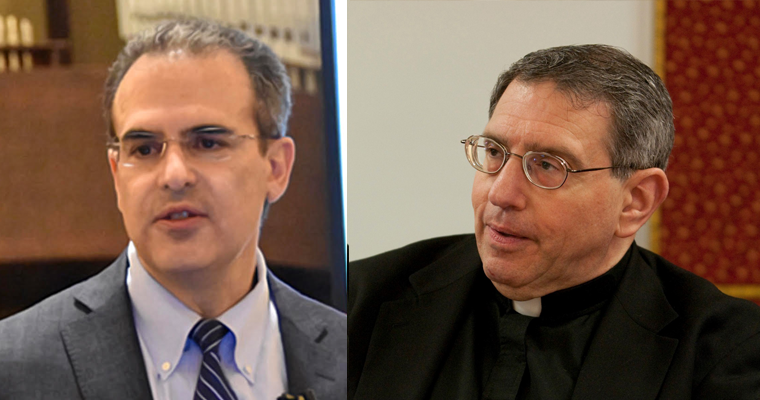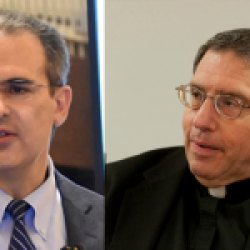By Dr. Paul Fiacco and Father Charles Vavonese | Special to the Catholic Sun
Editor’s note: This is one in a series of articles that will explain and explore the Church’s teachings on end-of-life and palliative care issues.
Dr. Paul Fiacco is the president and medical director of CNY AIM, a St. Joseph Health clinically integrated network (CIN), and the medical director of the Trinity Health Integrated Care AGO. He is also a full-time family physician at CNY Family Care in East Syracuse. Dr. Fiacco is a parishioner at Holy Cross Church in DeWitt.
Father Charles Vavonese is a retired priest of the Diocese of Syracuse, and was the author of “I Am the Resurrection and the Life,” a resource booklet dealing with end-of-life moral issues which is no longer available. He currently serves patients receiving palliative care as the chaplain for the St. Joseph Health Mobile Integrated Services Team. In addition, he assists on weekends at Holy Cross Church in DeWitt.
The previous article discussed St. Marianne Cope’s heroic care for those afflicted with Hansen’s disease. She is inspirational to the current work known as palliative care, the care delivered to patients with serious illness that prevents or relieves the symptoms and side effects caused by the disease and its treatment. Palliative care’s focus is to make the patient as comfortable as possible, and to maintain a quality of life from the time of a patient’s diagnosis through all stages of disease.
In addition to treating patients’ physical issues, palliative care also focuses on the burdens that disease and its treatment has on patients, families, and caregivers and supporting them both emotionally and spiritually. Palliative care is delivered by a team of caregivers, providing life-affirming, comprehensive, and interdisciplinary care for individuals with serious illness and their families.
Traditional palliative care
Palliative care is traditionally delivered during a hospitalization or skilled nursing facility admission. The effectiveness of this delivery becomes limited due to the advanced stage of a patient’s illness, and the burdens already felt by patients and their families. Palliative care is most effective if implemented at the time a serious illness is diagnosed.
Palliative care is not exclusively provided in a hospital or nursing home setting. Many people indicate a preference to be at home and making this possible often depends on several factors, such as the nature of the illness, the amount of care the person needs, how much support is available from the person’s family, and whether the person has someone at home who can provide physical care and support for them.
A new model for palliative care delivery
Across the country, a movement is underway to improve on the current health care delivery system with the intention to introduce palliative care earlier in the course of a serious illness. This model is known as community-based palliative care and is associated with improved quality of life and decreased depression.
There are four principles necessary for a successful community-based palliative care program: 1) Delivery of aggressive symptom management; 2) Working with patients and their care team(s) to set treatment goals; 3) Providing psychosocial and spiritual support to patients and their families; and 4) Planning for end-of-life care.
One such community-based palliative care program is found in Onondaga County; it is known as the Mobile Integrated Service Team (MIST) Program. It was developed by the Population Health Team at St. Joseph’s Hospital Health Center. The mission of the MIST team is to provide comprehensive care to the most vulnerable in the community that cannot otherwise access care through in-office services. The MIST team focuses on relieving the symptoms, pain, and stress of serious illness. The goal is to improve the quality of life for both patients and family. Team members work with a patient’s doctors and others to provide an extra layer of support, and also provide appropriate care as the patient experiences changes in his/her condition.
The MIST program is designed to support primary care providers by managing complex medical and social needs of the most vulnerable patients directly into their homes. This coordinated-care delivery team consists of a program manager, nurse practitioner(s), nurse manager, social worker, and chaplain.
The program manager coordinates members of the team, screens referrals, and ensures program compliance; he or she also navigates appropriate legal regulations and hospital policy. The nurse practitioner(s) provides the necessary in-home care in coordination with the patient’s primary care physician. A nurse manager coordinates care with primary care physician offices, insurance companies, and mobile testing agencies. They interact with patients and families, arrange transportation for patients, and coordinate patient care with other agencies caring for the patient. The social worker provides interpersonal counseling and assists with applying for housing, Medicare, SSDI, Meals-on Wheels, Call-a-Bus, etc. Chaplains support patients and their families in coping with serious illness and its treatment. They assist in prayer, deliver any sacraments, and seek to alleviate past emotional trauma. In essence, they assist in advanced care planning and prepare patients for the end of life. A care coordinator assistant works to organize patient appointments.
Summary
St. Marianne Cope is an inspiration to the current work known as palliative care, the care delivered to patients with serious illness that prevents or relieves the symptoms and side effects caused by serious disease and of its treatment.
A community-based palliative care program allows patients to maintain their independence in their homes as they cope with the progression of their illness and treatment. A successful community program includes: delivering aggressive symptom management; working with patients and their care team to set treatment goals; providing psychosocial and spiritual support to patients and their families; and planning for end-of-life.
The goal is to improve the life and care of patients and their families while reducing the burdens caused by their illness and treatment. The success of these programs and the ability to reach more vulnerable patients in our community depends on an expanded collaboration between the Church and other faith communities and healthcare system networks. Palliative care becomes a powerful antidote to euthanasia and physician-assisted suicide.
Next article
Palliative care also focuses on understanding a patient’s and family’s values to help guide moral, medical, and health-related legal decisions. Our next article will focus on the health care legal documents that need to be considered when dealing with end-of-life issues.





